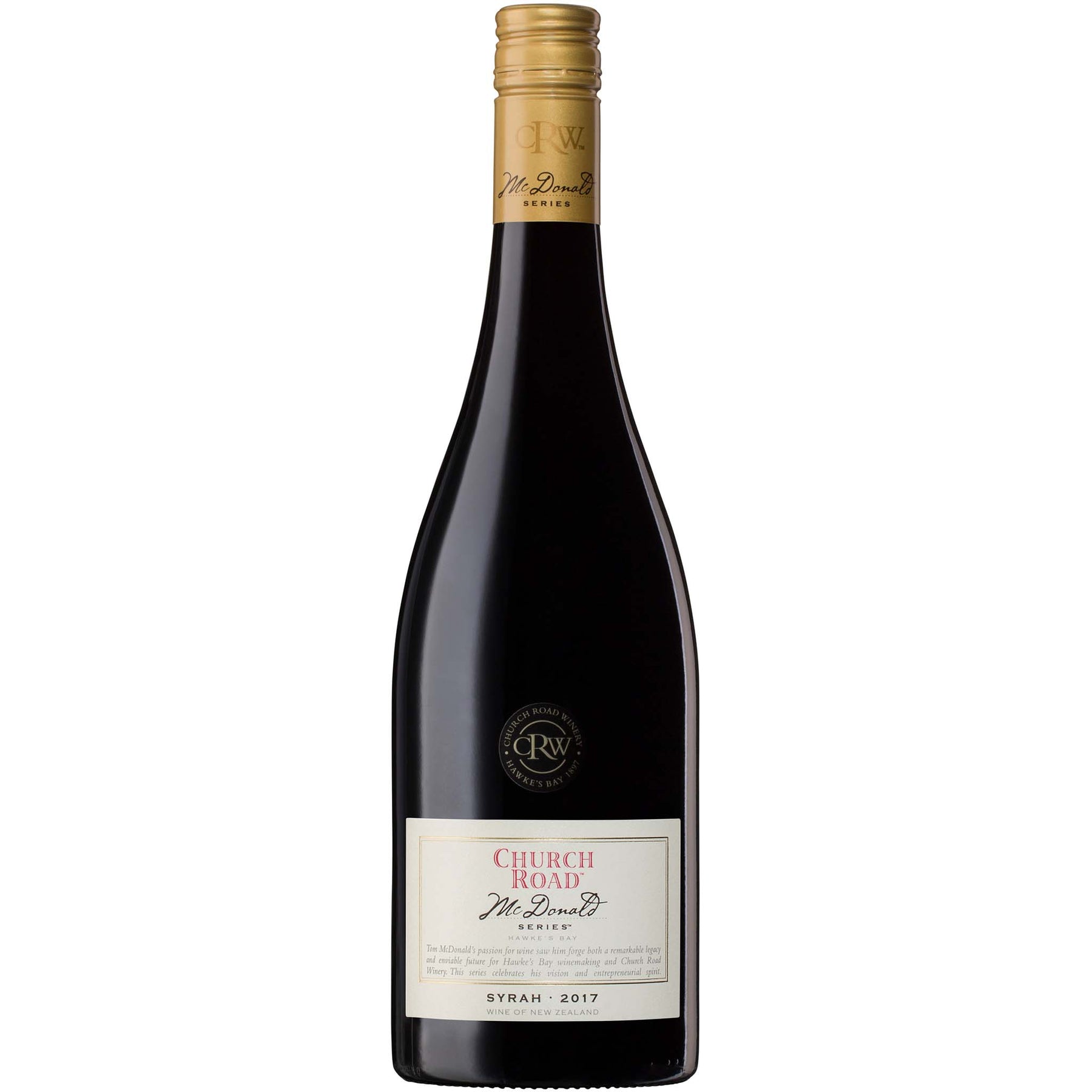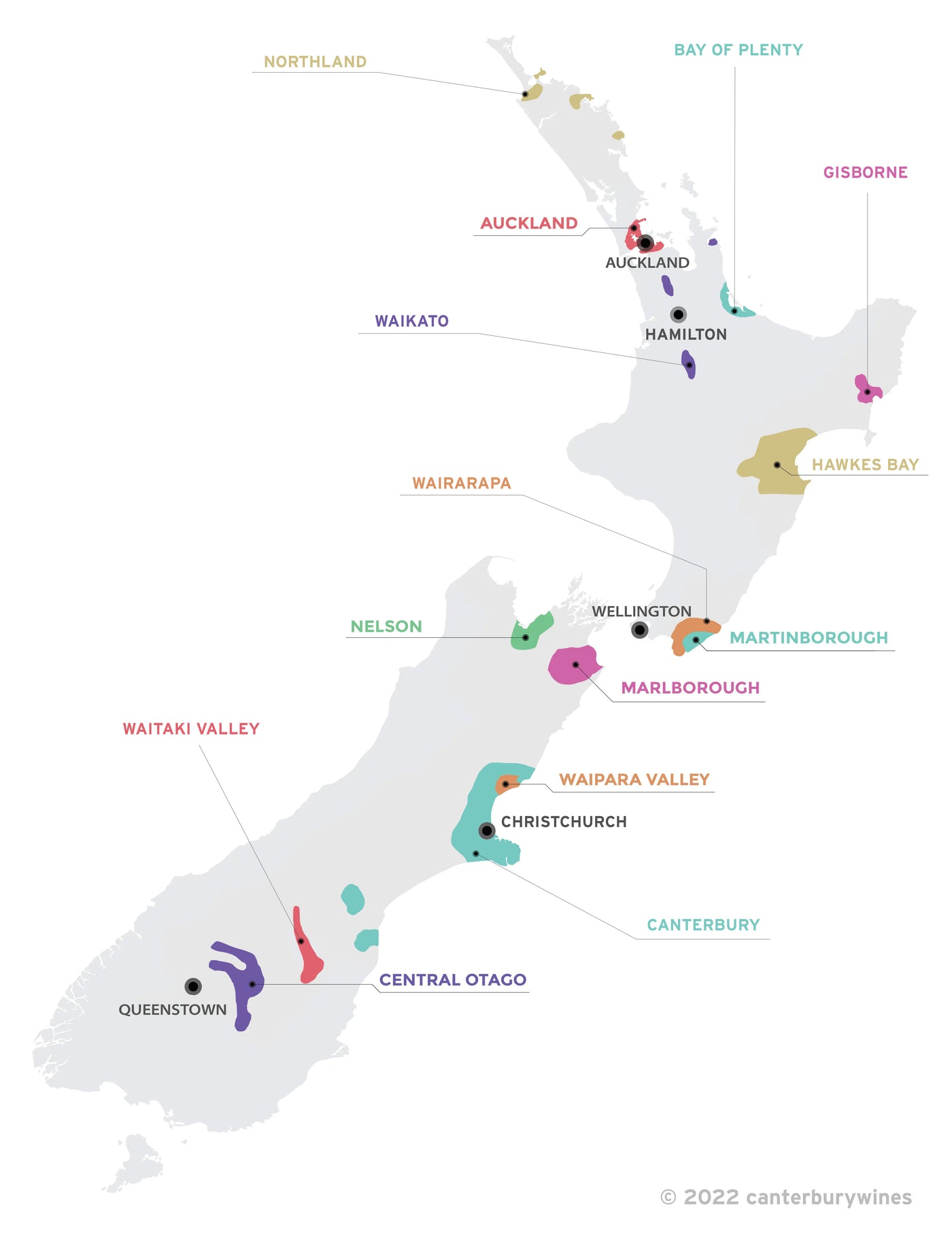

Church Road McDonald Series Syrah 2017
Style: Red Wine
Closure: Screwcap
Church Road McDonald Series Syrah 2017
Warehouse
34 Redland Drive
Vermont VIC 3133
Australia
Producer: Church Road
Country: New Zealand
Region: Hawke's Bay
Vintage: 2017
Critic Score: 95 and ★★★★(★)
Alcohol: 13.5%
Size: 750 ml
Drink by: 2029
"The takeaway message is that Church Road knows a thing or two about making high-quality syrah." Huon Hooke
Church Road's McDonald Series was created as a tribute to former 14-year-old worker Tom McDonald, who went on to run and later purchase the winery and is considered the pioneer of modern winemaking in Hawke's Bay. The 2017 McDonald Series Syrah is a blend of fruit from the Gimblett Gravels and Bridge Pa sub-regions in Hawke's Bay.
"Light, fragrant and pretty. Elegance personified. Violets, cassis, black pepper and mixed spices abound in this floral, savoury fine-grained red." Nick Munday
"Just a mention of the wine lights a spark in Chief Winemaker Chris Scott's eyes. A spark – and a knowing smile – shared between all of the Church Road winery staff. They’re onto something you see, onto a 'new' variety that represents an exciting new chapter in the 105 year Church Road winery history. The wine is a Syrah, a cool, juicy, spicy Syrah, grown in the old gravel riverbeds that New Zealand's Hawke’s Bay region is known for. What makes this wine, this 'newish' (for New Zealand) grape, so significant is just how much promise it shows.
Here in Australia we almost take Syrah (or Shiraz) for granted – it grows like a weed in our warm climes, and has done so for over 170 years. It is only in the last decade however that this most famous grape has carved a serious reputation in NZ, the plantings growing from just a single row in 1984 to a (still small, but significant) 300 hectares in 2013.
For Chris Scott, Syrah was originally just a dalliance – an experimental wine to keep the winemaking team on their toes. It took a big win (Champion Wine of Show at the 2008 NZ Wine Awards) for just the second ever Church Road Syrah to provoke more than a passing interest! What Syrah now represents is a third string to the Church Road bow – a third wine to compliment the Chardonnay and Cabernet Sauvignon blends that the winery is most famous for." Andrew Graham, Australian Wine Review (Feb 2013)
Expert reviews
"A blend of Redstone vineyard and Church Pa fruit. Light, fragrant and pretty. Elegance personified. Violets, cassis, black pepper and mixed spices abound in this floral, savoury fine-grained red." Nick Munday, Canterbury Wines - 95 points
"The 2017 vintage is an age-worthy, intensely varietal red, grown in the Gimblett Gravels and Bridge Pa Triangle. Deeply coloured, with a highly fragrant, fresh, spicy bouquet, it is mouth-filling, with strong, youthful plum and black-pepper flavours, showing good complexity, and a long finish. Best drinking 2021+." Michael Cooper's Buyer's Guide ★★★★(★)
Tom McDonald
 In 1921, Tom McDonald, a 14-year-old school leaver of Scottish extraction, was employed by the winery to wash recycled bottles. Tom was a rather entrepreneurial young man, and by the age of 19, Tom had leased the entire property and ran the business as his own. By the time he was 29, Tom purchased the property outright, before selling a shareholding to raise capital for expansion.
In 1921, Tom McDonald, a 14-year-old school leaver of Scottish extraction, was employed by the winery to wash recycled bottles. Tom was a rather entrepreneurial young man, and by the age of 19, Tom had leased the entire property and ran the business as his own. By the time he was 29, Tom purchased the property outright, before selling a shareholding to raise capital for expansion.
Not only did Tom have a head for business, but he also developed a passion for the great wines of France. At a time when the New Zealand industry was largely entrenched in cheap fortified wine production, Tom initiated the first commercial plantings of Cabernet Sauvignon and Chardonnay in Hawke's Bay. He released the country's first commercial Cabernet Sauvignon in 1949. Quality steadily increased and by the 1960s New Zealand's wine connoisseurs snapped up McDonald's wines year after year.
Tom McDonald retired in 1976 after a 50 year reign at Church Road. During his hugely transformational tenure at the helm, he not only revolutionized winemaking practices but also became a celebrated wine show judge, rising to become Chief Judge for the NZ Wine Show.
He subsequently passed away in 1987, leaving behind a legacy of quality winemaking. He is regarded as one of the founding fathers of the New Zealand wine industry and is considered the pioneer of modern winemaking in Hawke's Bay. His contribution was recognised in 1974 when he was awarded the prestigious Order of the British Empire.
About the winery
 The Church Road winery was established in 1897 by Bartholomew Steinmetz, a Luxembourg émigré who had come to New Zealand to make wine for the Marist Brothers Catholic Mission. Steinmetz returned to his native Luxembourg in the 1920s, leaving his winery in the hands of the 19-year-old Tom McDonald, who had been working for him since his early teens.
The Church Road winery was established in 1897 by Bartholomew Steinmetz, a Luxembourg émigré who had come to New Zealand to make wine for the Marist Brothers Catholic Mission. Steinmetz returned to his native Luxembourg in the 1920s, leaving his winery in the hands of the 19-year-old Tom McDonald, who had been working for him since his early teens.
Tom was a rather entrepreneurial young man. He leased the entire property and ran the business as his own. By the time he was 29, Tom had purchased the property outright, before selling a shareholding to raise capital for expansion.
Tom McDonald pioneered the creation of the Hawke's Bay wine industry and his lifelong dedication to crafting fine wines helped establish the region's international reputation as a high quality wine region.
Tom McDonald retired in 1976 and the winery carried on winemaking up until 1981 when a change of ownership saw the winery slowly shut down.
The Church Road Winery was renovated and reopened in 1989 with the express purpose to re-establishing it at the heart of quality red winemaking in New Zealand. The 1990 vintage saw their first release of Chardonnay, Cabernet Sauvignon and Merlot.
Chris Scott, four-time Winestate New Zealand Winemaker of the Year, was appointed Chief Winemaker in 2005 and under his guidance the winery has gone from strength to strength. He and his team draw upon an exceptional array of varietals sourced from some of Hawkes Bay’s top vineyard sites.
In 2005 the winery was acquired and further developed by Montana Wines (now Pernod Ricard NZ).
"I have the utmost respect for the winemaking and viticultural skills of Chris and his team. They have the remarkable ability to produce exceptional wines in challenging vintages and truly stellar wines in favourable years such as 2020 and 2021." Bob Campbell MW, The Real Review

Church Road Winery and Hawke's Bay sub-regions

New Zealand
New Zealand is home to more than 700 wineries across 14 wine regions. The regions are Auckland, Bay of Plenty, Canterbury, Central Otago, Gisborne, Hawkes Bay, Marlborough, Martinborough*, Nelson, Northland, Waikato, Waipara Valley, Wairarapa and Waitaki Valley. * Martinborough is a sub-region of Wairarapa, however, as it is world renowned it is considered here to be a region to avoid confusion.
The wine regions in New Zealand stretch from latitudes 36°S (Northland) in the north (comparable in latitude to Jerez, Spain), to 45°S (Central Otago) in the south (comparable in latitude to Bordeaux, France). New Zealand's climate is maritime, producing cooler summers and milder winters than would be expected at similar latitudes in Europe.
Viticulture in New Zealand dates back to 1836 when British resident James Busby produced wine in the far north, but it wasn't until 1985 that the wine industry came of age when Cloudy Bay Sauvignon Blanc garnered international attention and critical acclaim.
New Zealand is internationally renowned for Sauvignon Blanc (particularly from Marlborough), Pinot Noir (Central Otago, Martinborough and Waipara Valley), Chardonnay, Bordeaux-style blends of mainly Merlot and Cabernet Sauvignon (Hawkes Bay) and Syrah (Hawkes Bay). Sauvignon Blanc accounts for 63% of the area of the national vineyard, followed by Pinot Noir (14%), Chardonnay (8%), Pinot Gris (7%) and Merlot (3%).

